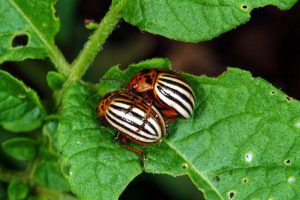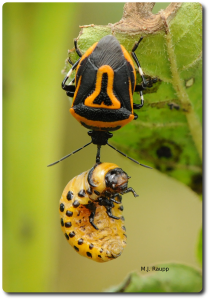Commonly called the potato bug, the Colorado potato beetle can cause serious stunting in potato plants, especially if it attacks plants while tubers are beginning to bulk up. This occurs due to large-scale defoliation of the plant’s leaves.
To combat Colorado potato beetles that may infest your garden or fields, several pest management measures will need to be implemented. An understanding of the behavioral pattern of these beetles, as well as their vulnerabilities will help individuals employ the best Colorado potato beetle control. This may involve the use of biological, as well as chemical procedures.
Colorado Potato Beetle Control for Potatoes and Plants
-
Reduce Food Supply During Springtime
During springtime when the Colorado potato beetles emerge, it’s important that gardeners remove the food sources of these pests in cases where this is possible. Food sources that attract Colorado beetles and should be removed include nightshade, ground cherry or weeds. You may also consider planting potatoes later in the year as the beetles will eat the young potato plants if they are available when they emerge during the spring season.
Also, clear away excess shrubs, weeds, and woodpiles which would otherwise encourage other pests to invade your surroundings.
-
Remove Colorado Potato Bugs by Hand
If you are not squeamish about bugs, handpicking Colorado beetles from the leaves of plants, as well as soil won’t be difficult. This Colorado potato beetle control method is of course more effective in small gardens where smaller populations of the bugs are present. If this is the case for you, simply get a small pail or container. Ensure the container you use is filled with soapy water as this will impede the beetles’ ability to crawl out. You can also spray plants with a soap and water solution to help in the removal of the beetles.
 Be very vigilant when removing larvae and adult beetles, as Colorado beetles at these stages are responsible for the extensive damage inflicted upon potato foliage, tomato, and eggplants. Also, check the underside of leaves for signs of the eggs. These are usually seen in clusters and are yellow-orange in color. Crush the eggs between your fingers to prevent them from hatching. Wear gloves where necessary.
Be very vigilant when removing larvae and adult beetles, as Colorado beetles at these stages are responsible for the extensive damage inflicted upon potato foliage, tomato, and eggplants. Also, check the underside of leaves for signs of the eggs. These are usually seen in clusters and are yellow-orange in color. Crush the eggs between your fingers to prevent them from hatching. Wear gloves where necessary.
In addition, check your potato plants regularly to ensure you keep the Colorado potato beetle population under control. After all, the female beetles can lay several hundred eggs during their lifetime. If these females or their eggs are left undetected, this could result in a recurring problem with the infestation soon becoming bigger than any gardener or homeowner can handle.
-
Use Insect Pathogen, Bacillius thuringiensis
Bacillius thuringiensis var tenebrionis (Bt) is a bacterial pathogen which can be used for Colorado beetle control. This bacterium is sold commercially and highly effective in killing the beetles in their earliest stages, particularly the larvae. Bt products contain toxins that poison the beetle’s body, resulting in loss of appetite and death within a few days. Since this bacterium occurs naturally in the soil, it is also an organic solution for those who are wary of using chemical-based insecticides.
-
Introduce Natural Predators for Colorado Beetle Control

The Colorado potato beetle larva dangling from the beak of the adult two-spotted stink bug.
A s is the case with handpicking Colorado potato beetles, the use of natural predators to control the population of these beetles is most effective when the infestation is not extreme. If your garden is affected by just a few dozen beetles or less, consider using lady beetles and stink bugs. Both of these natural predators consume Colorado potato beetle eggs and are available at garden supply stores or online.
Before purchasing these insects, however, ensure you really are experiencing a Colorado beetle infestation. You’ll be able to identify these bugs easily thanks to the ten black stripes on the backs of the adult beetles or the two rows of black spots that line the sides of the larvae.
-
Apply Insecticides
Though many insecticide products feature claims regarding their effectiveness at combating Colorado beetle populations, only a few are effective. This is due to the fact that these beetles have developed a high level of resistance to numerous insecticides over the years.
For this reason, individuals experiencing Colorado potato beetle infestation in their home gardens should be very cautious when applying insecticides. Consider contacting a pest control expert to determine which insecticides are most effective against Colorado beetles in your area.

No Comments